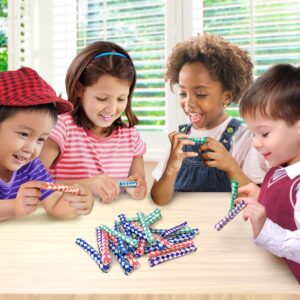Finger traps are simple yet intriguing little toys made from woven bamboo, paper, or plastic. They consist of a hollow, tubular structure with open ends. When you insert your fingers into each end and attempt to pull them out, the trap tightens around your fingers, making it challenging to free yourself.
The more you try to escape by pulling your fingers apart, the tighter the trap becomes. To release your fingers, you need to push them together, which loosens the trap and allows you to slip your fingers out.
These finger traps, often seen as novelty toys or puzzles, offer more than just amusement. They can serve as powerful teaching tools, particularly when it comes to addressing friendship challenges and impulsive reactions among elementary-aged students.
Impulsive Reactions and Escalating Conflicts
Toward the end of the school year, friendships and relationships can become more challenging for elementary-aged students. Emotions run high, and conflicts arise more frequently. In the face of friendship drama, students often respond impulsively, without considering the consequences of their actions. As a school counselor, I have found that finger traps can be valuable tools to teach elementary students how to respond thoughtfully to friendship challenges.
Pulling Apart vs. Pushing Together
Interestingly, the counterintuitive lesson from the finger trap holds true in many real-life situations, including friendship challenges. When faced with conflicts, our instinct may be to pull away, respond impulsively, or defend ourselves. However, such reactions often exacerbate the situation, making it worse instead of better. By introducing the finger trap and its counterintuitive solution, we engage students’ curiosity and encourage them to consider alternative approaches, or ways to push together, to resolve conflicts with friends.
Teaching Students to “Push Together“
- Empathy plays a crucial role in navigating friendship challenges. Guide students to step into their friends’ shoes and understand their feelings and perspectives. By fostering empathy, students can develop a deeper sense of understanding and compassion, laying the foundation for meaningful and supportive friendships.
- Clear and respectful communication is essential for resolving conflicts. Using the finger trap as a metaphor, discuss the importance of active listening, expressing emotions constructively, and using “I” statements. These strategies help students communicate their thoughts and feelings effectively, creating a space for open dialogue and conflict resolution.
- Collaboration and problem-solving skills are essential for maintaining healthy friendships. With finger traps, encourage students to work together, brainstorm solutions, and evaluate different approaches. By focusing on finding win-win solutions, students learn the value of compromise and collaboration. They understand that the best outcomes are achieved when everyone’s needs and perspectives are considered.

Turning Little Life Lessons into Big Life Skills
Incorporating finger traps as teaching tools enables us to guide elementary students towards thoughtful problem-solving in their friendships. By understanding the counterintuitive lesson of pushing together in the face of challenges, students learn to respond with empathy, effective communication, and collaborative problem-solving.
Through finger trap exercises, students develop crucial skills that will benefit them not only in their current friendships but also throughout their lives. They learn to navigate friendship drama with thoughtfulness and understanding, creating a more harmonious and supportive school community.
As a school counselor, I have the privilege of equipping students with tools that extend beyond the classroom. Finger traps offer more than just a playful challenge; they provide valuable life lessons. By embracing the counterintuitive solution, students can overcome impulsive reactions and approach conflicts with empathy, communication, and collaboration.
So, the next time you encounter a finger trap, remember its deeper significance. It serves as a reminder to push together when faced with challenges, both in the toy itself and in the complexities of friendship. Let us continue to empower elementary students with the skills and mindset needed to build resilient friendships and create a brighter future.

